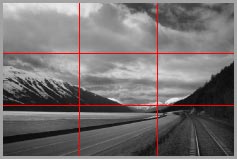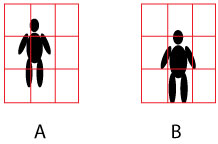How to take great photos
 |
Here's the best trick to help you take great pics. It's called "the rule of thirds." Basically what you want to do is split your view into thirds, like a tick-tack-toe board. (A lot of cameras already have some kind of grid in the view port.)
|
 |
The idea is to position one of the following ""things" at one of the intersections, or upon one of the lines. 1. The most interesting
thing
|
 |
For example, if shooting a landscape, you would position the horizon on either the top horizontal line, or the bottom horizontal line. Here we have the standard landscape, with the distant mountains at point 4. Also note how everything converges on point 4? Which also happens to be the most interesting aspect of the photo. |
 |
When taking close ups of people, the eyes would be located along the top horizontal line, and hopefully, one of the eyes would be right at one of the intersecting points. Eyes are very interesting, and they offer some decent contrast. Humans have a tenancy to fixate on eyes. Eyes are very interesting. It's OK to chop off the top of the head. Really. Try it, you'll like it. |
 |
Another thing to consider is direct-center verses off-center. In the image to the left the X represents "dead-center." The dot is positioned slightly off-center and has a more natural feel The mind has a tenancy to "weigh and balance" things. It is simply more pleasurable to look at the dot when it is off center.
|
 |
Image "A" has the dot off center (high) which makes the image feel a little more powerful and authoritative. Image "B" has the dot dead-center. It feels symmetrical, mechanical and un-natural. To me the dot looks like it's falling or sagging.
|
People |
|
 |
Portraits are a great way to show how this theory works. Most folks place the head dead-center, as in image "B." Doing this causes the image to have a lot of "white space" over the head. Think about it, do you really care what is above the persons head? The viewer of the photo is interested in the person-- not their surroundings. The most interesting thing about a person's face is their eyes. Hence, positioning the person so that the eyes are aligned with the grid is the way to go -- as in image "A." Some folks may think "hey, the head is chopped off !!" Believe it or not, that is OK. It may feel awkward at first, but take a look through any magazine and you'll discover that, indeed, many heads are chopped off! |
 |
That is why most portraits are "vertical." We can see that in image "B" centering the head leaves too much white space above the person. Moving the person's head to the top of the frame and aligning the eyes with the grid makes the image "more full."
|
 |
A good "rule of thumb" is: The top of the head should touch the top of the frame. Or the top of the head should be as close to the top of the frame as possible. This is a little more practical thing to remember when snapping photos "on the fly." All four images to the left are acceptable. It is important to note that although this rule is good to follow, it may not always apply. There needs to be a balance between the rule of thirds and minimizing the "dead space" above the person.
|
 |
Keeping the head close to the top of the frame becomes crucial when taking 3/4 or full shots. Images "A" are more acceptable because in images "B" there is too much white space above the person. Even though the "grid" rule dictates that the head / eyes need to be positioned at a "third" -- this rule gets "over-ruled" because there is too much white space above the person. Again, we are more interested in the person -- not their surroundings. So keeping the head close to the top of the frame works to our advantage.
|
|
Keep as much of the person in the frame as you can. If you can fit the entire body into the frame, then do so. In image "B" the person's knees are chopped off. Granted, the head is aligned to the grid, but a couple things stand out: 1. There is too much white space above the person. 2. Why did the knees (or feet) get chopped off when there is ample space to include more of the person? (e.g. The white space above the person is "dead space" that could have been used to show more of the person.) In image "A" we've moved the person up so that their entire body is within the frame. We've also moved the person to the left in order to provide a more dynamic layout.
|
 |
When deciding to position the person to be off-center, you'll need to consider a couple of things: 1. Is the person looking or facing in toward the center of the frame? It is important to always try and have the person face toward the center of the image. For example, if the person is facing to the right, then position them off to the left so that they are facing in toward the center of the frame. 2. Is their body position angled in a way that is detrimental to the overall picture -- perhaps moving the person more toward the center would be better? 3. Is there something of interest (other than the person) -- or -- is the person looking at something interesting that can also be positioned on the grid? People look at things that other people are looking at. In other words, if the person in the picture is looking at something, then the viewer of the photo will immediately look at the thing the person in the photo is looking at. The "thing" becomes the prominent "point of interest." Hence the "thing" should be positioned close to an intersection point in the grid.
|
 |
Don't be a "grid nazi." The grid is simply a starting point, and should not take prominence over the idea chopped off feet make for silly pictures. Again, if you can fit the entire person into the picture, then do so. For example, in image "A" the head is near an intersection point at the expense of clipping off the feet. It would be better to get the feet into the picture and see the person "whole" as in image "B."
|
Summery |
- Align the most interesting "thing" to the grid. - The top of the head should touch the top of the frame. - Keep as much of the person in the frame as you can. - Close ups: It's OK to clip the tops of peoples head. (Just ask any hair dresser :)
|
© Michael Gieson


